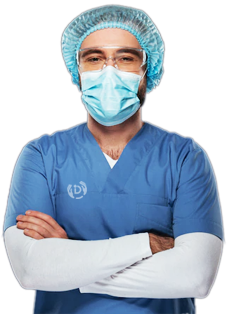What is Robotic Surgery?
Many patients are skeptical about robotic surgery, assuming that it is a robot
that does the decision-making during the surgery. But in reality, a robot is simply another tool for your
surgeon. When a surgeon performs a procedure using a robotic system, the surgeon is in the same room as
the patient. The surgeon uses a console to control the robot, and it gives him a three-dimensional view of
the operating field. The robot only responds to the surgeon’s precise hand and finger movements and will
never malfunction because of the safety features.
Are there any known side effects post robotic surgery?
They do not have any side effects because it is similar to laparoscopic
surgery. Robotic surgery is an apt solution for complex procedures, and it reduces the risk of infection
and bleeding.
What are the major benefits of Robotic Surgery?
Robotic surgery offers countless benefits. From a surgeon's perspective, it
allows him to operate in small or hard-to-reach areas that would be difficult or not possible to operate.
The robot allows for more precise vision, instrument control, and dexterity, making it ideal for the
procedures. The benefits for patients include reduced pain, faster recovery time, reduced blood loss,
minimal scarring, and shorter hospitalization.
Is it originally the robot that is doing the surgery?
NO. The complete control of the surgery is given to the surgeon. The robot is a tool for the surgeon and only moves when the surgeon's hands move. The surgeons manipulate the movement of the hands.
Should all surgeries be done robotically?
While the robot offers many advantages, it is critical that all patients are evaluated on an individual
basis. Not all patients are candidates for robotic surgery. Every patient and surgeon must discuss the
surgery goals, benefits, and risks before finalizing an approach.
Is Robotic Surgery safe?
More than 1000000 surgeries have been performed by surgeons over the years. The
robot has advanced features where the prime focus is to ensure the safety of patient. It enables the
surgeon to have a better high-definition image of the anatomy and will never malfunction because of the
unique safety features.
Difference between laparoscopic and robotic surgery?
Both surgeries are similar in terms of incision of the ports. What sets them
apart is the ability of the surgeon to visualize and perform the surgery with better tools. Robotic
surgery also overcomes some of the shortcomings of conservative laparoscopic or endoscopic techniques,
such as the assistant-dependent unstable video camera platform, two-dimensional view, restricted
ergonomics of the surgeon, instruments with limited degrees of freedom, and the absence of wrist gear.
In which all specialties robotic surgery is commonly carried out?
The potential applications of robotic surgery are growing constantly. At Daya
we have this application in General & Laparoscopic Surgery, Gastroenterology, Gynaecology, Urology and
Oncology. We can even repair hernia robotically that might have required a very large incision and
extensive hospital stay.



